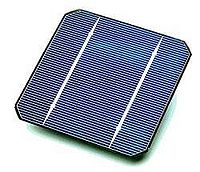The Photovoltaic Effect: Difference between revisions
Akresses99 (talk | contribs) No edit summary |
Akresses99 (talk | contribs) |
||
| Line 11: | Line 11: | ||
== Application == | == Application == | ||
[[File: | [[File:wifdki.jpg|200px|thumb|left|'''A Photovoltaic Cell''']] | ||
The photovoltaic effect is the evacuation of from a material due to the energy from photons in an incident light. We can harness the energy from this reaction with photovoltaic cells. This is because of the design on the photovoltaic or solar cell. The most basic of these cells are designed merely with two layers of a metalloid and an electrode. The top, or [https://en.wikipedia.org/wiki/P%E2%80%93n_junction n-type] layer of metalloid is generally composed of phosphorous [https://en.wikipedia.org/wiki/Doping_(semiconductor) doped] silicon. This is because the added phosphorous provides an excess of electrons on the top layer, and this allows for a greater chance of the photons from the incident light knocking loose these electrons. The bottom, or [https://en.wikipedia.org/wiki/P%E2%80%93n_junction p-type] layer of the cell is usually made of a boron doped silicon. This creates a highly positive layer, which in conjunction with the n-type layer, creates a charge gradient that allows for the movement of free electrons and is the basis for photovoltaic cells. | The photovoltaic effect is the evacuation of from a material due to the energy from photons in an incident light. We can harness the energy from this reaction with photovoltaic cells. This is because of the design on the photovoltaic or solar cell. The most basic of these cells are designed merely with two layers of a metalloid and an electrode. The top, or [https://en.wikipedia.org/wiki/P%E2%80%93n_junction n-type] layer of metalloid is generally composed of phosphorous [https://en.wikipedia.org/wiki/Doping_(semiconductor) doped] silicon. This is because the added phosphorous provides an excess of electrons on the top layer, and this allows for a greater chance of the photons from the incident light knocking loose these electrons. The bottom, or [https://en.wikipedia.org/wiki/P%E2%80%93n_junction p-type] layer of the cell is usually made of a boron doped silicon. This creates a highly positive layer, which in conjunction with the n-type layer, creates a charge gradient that allows for the movement of free electrons and is the basis for photovoltaic cells. | ||
Where the n-type and p-type layers meet, they form an electromagnetically stable barrier between the two layers that only allows electrons to flow from the p-type layer to the n-type layer. This allows the electrons that flow into the p-type layer through the [https://en.wikipedia.org/wiki/Electrode electrode] to return to the n-type layer and preserve the functionality of the photovoltaic cell. | Where the n-type and p-type layers meet, they form an electromagnetically stable barrier between the two layers that only allows electrons to flow from the p-type layer to the n-type layer. This allows the electrons that flow into the p-type layer through the [https://en.wikipedia.org/wiki/Electrode electrode] to return to the n-type layer and preserve the functionality of the photovoltaic cell. | ||
== Light Generated Current == | == Light Generated Current == | ||
Revision as of 21:19, 5 December 2015
CLAIMED BY AKRESSES99
The photovoltaic effect is the creation of electric current or voltage through a material upon exposure to light. It is a physical and chemical phenomenon in response to the transfer of energy from photons.

The Main Idea
The photovoltaic effect is directly related to The Photoelectric Effect, but they are different processes. When light strikes a material surface, the electrons present in the valence band absorb the energy from the photons energy and, being excited, jump to the conduction band and become free. The material is composed of crystallized atoms that are ionized and create an electric imbalance, that drives the electrons. These highly excited electrons diffuse and some reach a junction where they are accelerated into a different material by an electrode. This generates an electric current, so some of the light energy can be converted into electric energy. This current can then be used to power an appliance.
Application
The photovoltaic effect is the evacuation of from a material due to the energy from photons in an incident light. We can harness the energy from this reaction with photovoltaic cells. This is because of the design on the photovoltaic or solar cell. The most basic of these cells are designed merely with two layers of a metalloid and an electrode. The top, or n-type layer of metalloid is generally composed of phosphorous doped silicon. This is because the added phosphorous provides an excess of electrons on the top layer, and this allows for a greater chance of the photons from the incident light knocking loose these electrons. The bottom, or p-type layer of the cell is usually made of a boron doped silicon. This creates a highly positive layer, which in conjunction with the n-type layer, creates a charge gradient that allows for the movement of free electrons and is the basis for photovoltaic cells.
Where the n-type and p-type layers meet, they form an electromagnetically stable barrier between the two layers that only allows electrons to flow from the p-type layer to the n-type layer. This allows the electrons that flow into the p-type layer through the electrode to return to the n-type layer and preserve the functionality of the photovoltaic cell.
Light Generated Current
This expression defines the light-generated current in a photovoltaic cell, IL, as a function of solar radiation and the temperature of the cell. ST represents the intitial solar radiation, and ST,r denotes the reflected solar radiation. Tc and Tc,r are the cell temperatures before and after irradiation. IL,r is light-generated current at reference conditions, and μIsc is coefficient of temperature at short circuit current. The initial cell temperature, Tc, can be computed from the ambient reference temperature.
